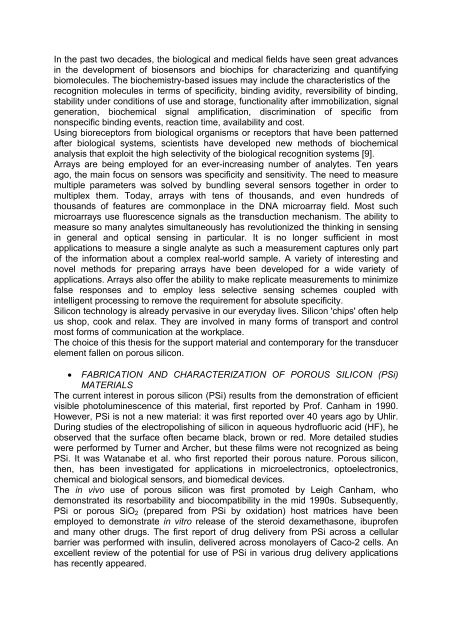PDF (tesi dottorato ROTIROTI) - FedOA - Università degli Studi di ...
PDF (tesi dottorato ROTIROTI) - FedOA - Università degli Studi di ...
PDF (tesi dottorato ROTIROTI) - FedOA - Università degli Studi di ...
Create successful ePaper yourself
Turn your PDF publications into a flip-book with our unique Google optimized e-Paper software.
In the past two decades, the biological and me<strong>di</strong>cal fields have seen great advances<br />
in the development of biosensors and biochips for characterizing and quantifying<br />
biomolecules. The biochemistry-based issues may include the characteristics of the<br />
recognition molecules in terms of specificity, bin<strong>di</strong>ng avi<strong>di</strong>ty, reversibility of bin<strong>di</strong>ng,<br />
stability under con<strong>di</strong>tions of use and storage, functionality after immobilization, signal<br />
generation, biochemical signal amplification, <strong>di</strong>scrimination of specific from<br />
nonspecific bin<strong>di</strong>ng events, reaction time, availability and cost.<br />
Using bioreceptors from biological organisms or receptors that have been patterned<br />
after biological systems, scientists have developed new methods of biochemical<br />
analysis that exploit the high selectivity of the biological recognition systems [9].<br />
Arrays are being employed for an ever-increasing number of analytes. Ten years<br />
ago, the main focus on sensors was specificity and sensitivity. The need to measure<br />
multiple parameters was solved by bundling several sensors together in order to<br />
multiplex them. Today, arrays with tens of thousands, and even hundreds of<br />
thousands of features are commonplace in the DNA microarray field. Most such<br />
microarrays use fluorescence signals as the transduction mechanism. The ability to<br />
measure so many analytes simultaneously has revolutionized the thinking in sensing<br />
in general and optical sensing in particular. It is no longer sufficient in most<br />
applications to measure a single analyte as such a measurement captures only part<br />
of the information about a complex real-world sample. A variety of interesting and<br />
novel methods for preparing arrays have been developed for a wide variety of<br />
applications. Arrays also offer the ability to make replicate measurements to minimize<br />
false responses and to employ less selective sensing schemes coupled with<br />
intelligent processing to remove the requirement for absolute specificity.<br />
Silicon technology is already pervasive in our everyday lives. Silicon 'chips' often help<br />
us shop, cook and relax. They are involved in many forms of transport and control<br />
most forms of communication at the workplace.<br />
The choice of this thesis for the support material and contemporary for the transducer<br />
element fallen on porous silicon.<br />
• FABRICATION AND CHARACTERIZATION OF POROUS SILICON (PSi)<br />
MATERIALS<br />
The current interest in porous silicon (PSi) results from the demonstration of efficient<br />
visible photoluminescence of this material, first reported by Prof. Canham in 1990.<br />
However, PSi is not a new material: it was first reported over 40 years ago by Uhlir.<br />
During stu<strong>di</strong>es of the electropolishing of silicon in aqueous hydrofluoric acid (HF), he<br />
observed that the surface often became black, brown or red. More detailed stu<strong>di</strong>es<br />
were performed by Turner and Archer, but these films were not recognized as being<br />
PSi. It was Watanabe et al. who first reported their porous nature. Porous silicon,<br />
then, has been investigated for applications in microelectronics, optoelectronics,<br />
chemical and biological sensors, and biome<strong>di</strong>cal devices.<br />
The in vivo use of porous silicon was first promoted by Leigh Canham, who<br />
demonstrated its resorbability and biocompatibility in the mid 1990s. Subsequently,<br />
PSi or porous SiO2 (prepared from PSi by oxidation) host matrices have been<br />
employed to demonstrate in vitro release of the steroid dexamethasone, ibuprofen<br />
and many other drugs. The first report of drug delivery from PSi across a cellular<br />
barrier was performed with insulin, delivered across monolayers of Caco-2 cells. An<br />
excellent review of the potential for use of PSi in various drug delivery applications<br />
has recently appeared.

















